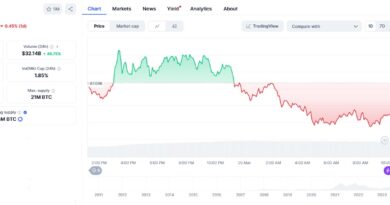Blockchain Bites: Bitcoin Crosses $11K While DOJ Takes Aim at Crypto

Ethereum’s success drives imitation.
Just take a look at the latest report from the crypto-industry publication DappRadar: In the third quarter of 2020, Ethereum accounted for 96% of the total transaction volume over decentralized applications, including the blockchain-based trading and lending networks that have exploded in popularity in recent months.
Prices for ether (ETH), the Ethereum blockchain’s native token, have nearly tripled in 2020 to about $350. Such returns make better-known bitcoin’s 52% year-to-date gain look paltry.
CoinDesk is preparing for the invest: ethereum economy virtual event on Oct. 14 with a special series of newsletters focused on Ethereum’s past, present and future. Every day until the event the team behind Blockchain Bites will dive into an aspect of Ethereum that excites or confuses us. Today’s introduction was written by markets editor Bradley Keoun.
But success has brought a slew of problems, such as network congestion that has slowed down transaction processing and pushed up average fee rates to record levels.
Ethereum’s 2.0 upgrade is supposed to boost processing speeds to 1,000 to 4,000 transactions per second, but for now the grumbling abounds. “Scalability has been a critical issue for Ethereum,” the analysis firm IntoTheBlock noted this week in a blog post.
All this creates an opening for competitors that are nowhere near ready to concede Ethereum’s first-mover advantage as the dominant smart-contract blockchain.
The list of challengers isn’t short. In no particular order, there’s Tron, EOS, Neo, Polkadot, Algorand, Cardano and Avalanche, among others. According to the data firm Messari, no fewer than 17 of these blockchains have tokens that trade, with market values of at least $100 million each.
Over the past year, Zilliqa’s ZIL token has returned the most, gaining 73% versus ETH. On the other end of the spectrum, EOS’ EOS tokens are down 56% in ether terms.
Some rivals aren’t looking to take on Ethereum per se, but are keen on stealing lucrative parts of the franchise.
Radix DLT says it’s one such firm – a blockchain built with the express purpose of becoming a home for the fast-growing cryptocurrency subsector of decentralized finance (DeFi).
CEO Piers Ridyard told CoinDesk in an interview this week that Ethereum’s one-size-fits-all model probably doesn’t cut the unique technical requirements of DeFi, and that’s crucial if operators are going to scale their platforms to the point where they could plausibly start to challenge big banks and Wall Street trading firms.
Ridyard is scheduled to appear on a virtual panel on Thursday, Oct. 14, at CoinDesk’s invest: ethereum economy conference, alongside Roham Gharegozlou of Dapper Labs. CoinDesk tech reporter Will Foxley is hosting. It’s at 5 p.m. Eastern time.
Ridyard said he’s not worried about Ethereum breaking away. The industry still has a long way to evolve, and there’s plenty of time to catch up or overtake the market leader.
“Technology moves at a breakneck speed and mind-numbingly slow pace at the same time,” Ridyard said. “Fundamentally we are still in the concrete-pouring phase of the industry.”
Featured panel
The Fees Are Too Damn High: DeFi Pushes Ethereum to Its Limit
Ethereum has delivered many mind-boggling innovations – some by design, others out of necessity. With DeFi pushing the ecosystem, existing infrastructure is being maxed out. Can Ethereum 2.0 address these pain points? Is this the opportunity for so-called “Eth Killers”? We assess this critical fork in the road as Ethereum looks to level up.
Join MakerDAO’s Rune Christensen, NEAR Protocol’s Illia Polosukhin and Framework Ventures’ Michael Anderson for a live stream starting at 9:30 a.m. ET.
$1B BTC
At invest: ethereum economy on Oct. 14, we will address the ramifications for investors as decentralized finance takes the crypto world by storm.
In a run-up to the event, our two-part CoinDesk Live: Inside the Ethereum Economy virtual miniseries introduces trending narratives we will break down at the main event: Why all the hype behind yield farming and food-inspired tokens? Should investors take them seriously or are they a fading trend?
Whether it’s wBTC, renBTC or tBTC, tokenized bitcoin is the hottest thing on Ethereum right now. A phenomenon that hardly existed at the beginning of this year has pushed the total value locked in bitcoin past $1.3 billion.
On Oct. 12, CoinDesk markets reporter Zack Voell discusses the yield farming phenomenon with Matt Luongo of Thesis, Jeff Garzik of Bloq, Loong Wang of Ren Project and Kiarash Mosayeri of BitGo.
Watch Bitcoin’s $1 Billion Crop: Why Hodlers Are Harvesting Yield on Ethereum on Oct. 12, streaming on CoinDesk.com, Twitter and YouTube.
Ethereum 101
Non-fungible tokens (NFTs) are the latest decentralized tools to send the Ethereum economy into warp speed. NFTs are ways to append real-world or digital objects to a blockchain, usually Ethereum.
First brought to public consciousness in 2017 with the success of CryptoKitties, the sector is still largely focused on the goofy and surreal – there’s a booming art world, gaming sector and now even a place to itch your NSFW desires.
Brady Dale was the first to break down why and how NFTs got roped into the decentralized finance craze.
NFTs meet DeFi
NFTs have not captivated investor attention until quite recently because lending, borrowing and risk management – what we now call DeFi – have taken up all Ethereum’s oxygen in 2020. So Ethereans largely lost interest in NFTs there for a while – and who could blame them? You could buy them and sell them, and sometimes games would come together, but they seldom held players’ attention for very long. There were more dynamic markets to game; art’s fine but money is money.
Even when there had been buzz, some projects would rise up only to fade away, revealing a weakness in the NFT specification. CryptoStrikers, for example, a sports memorabilia project launched during the World Cup is long gone (soccer-focused Sorare has emerged in its wake).
Why is the marriage of non-fungible tokens (NFTs) and decentralized finance (DeFi) happening now? It’s debatable but you can make an argument that it comes back to DeFi’s favorite robo-advisor for yield: Yearn.Finance.
When the DeFi gateway created Y.Insure, a way to do KYC-free insurance on any crypto asset, it used NFTs to represent the policy with insurers. So, once reminded of ERC-721’s existence by DeFi’s top Chad, the industry ran with it.
That’s the short story, the long story involves the financialization of these tradable assets.
Financialization
As much as people like owning expensive stuff in crypto, they like owning stuff they can sell whenever they want even more (call it a liquidity fetish). NFTs had managed to be expensive but they had not managed to be liquid, not until DeFi-thinking intervened.
The stranger products are emergent phenomena of that financialization. Brukhman gave the example of Ark Gallery, which is a DAO for CryptoPunks. The punks were made pre-ERC-721 and have become quite valuable as early, cool and rare (there are only 10,000 such punks, each completely distinct). Ark allows people to crowdfund a punk (owning a fraction of the token) and then voting on whether or not to sell it if there’s an offer.
If there is a successful offer, everyone gets a proportionate share of the payment, based on how much they own. This has made CryptoPunks trade at ever-higher prices, allowing more people to feel like they had a piece of one. It’s clear that the spikes in volume have gone much higher this year when viewed on NFT data site NonFungible.com.
NIFTEX has taken that even further. Launched early this year with funding from Digital Currency Group (CoinDesk’s parent company), NIFTEX started off creating indices for NFTs, such as digital real estate or digital cards. But the real innovation kicked off when the firm fractionalized expensive NFTs into what it calls shards (really, just ERC-20 tokens – fungible slivers of previously singular digital assets).
The shard system works somewhat like what Ark Gallery does, except only someone who holds one of the ERC-20 tokens that represents partial ownership of an item can make an offer. The offer automatically succeeds if it fails to receive enough objections in two weeks, with a clever strategy built in to punish low-ball bids.
NIFTEX did its first fractionalization in May and, like Ark, the firm is seeing a lot more liquidity. Shard holders own a fractionalized, extremely rare Axie Infinity card called Almace that saw over 1,000 ETH transacted in its first week after sharding. Joel Hubert, one of the two co-founders, estimated its liquidity all year would have been more like 300 or 400 ETH in a few trades, without sharding.
On NonFungible, Axie Infinity shows appreciably more dollars getting transacted even if the volumes are only bumped up slightly.
“I like where we’re at because Ethereum is all about experimentation,” Hubert said.
The larger point to all of this is that content is finding a path to fair remuneration on the internet.
Added Flamingo’s Desai, “When you start talking about how content creators are paid, that’s where DeFi comes in; and when you start talking about property of creators, that’s all NFTs.”
The ledger
While NFTs are usually written off as merely game pieces, like all decentralized technologies they have the power to bring financial services to the un- or underbanked. Just as the technology transcends particular blockchains, so too can it move beyond borders.
Leigh Callon Butler, a CoinDesk columnist and director of the consulting firm Emfarsis, wrote about an NFT game Philipinos turned to for making money during the coronavirus shutdown. (This excerpted essay was published first in August.)
Fun and games
In the Philippines, one popular blockchain-based game is even providing pathways out of poverty and helping spread the word about novel technology. Created by Sky Mavis, a Vietnamese startup, Axie Infinity is a decentralized application (dapp) on the Ethereum blockchain where players breed, raise, battle and trade adorable digital critters called Axies.
Ijon Inton, an Axie player from Cabanatuan City, which is about 68 miles north of Manila in the province of Nueva Ecija, first learned about it in February of this year when his friend stumbled across an explainer video on YouTube. Intrigued by the “Play to Earn” element of the game, he decided to give it a go.
“At first I just want to try its legitimacy, and after a week of playing I was amazed with my first income,” said Inton, who is currently earning around 10,000 PHP ($206) per week from playing the game around the clock.
Inton soon invited his family to play, too, and after a few weeks, he also started telling his neighbors. A crypto trader since 2016, Inton helped his friends set up a Coins.ph account so they could buy their first ETH and get started. Now, there are more than 100 people in his local community playing to earn on Axie, including a 66-year-old grandmother.
The COVID-19 crisis, which has confined people to their homes and limited the usual opportunities to earn an income, combined with the compelling nature of the Axie game itself, has encouraged people who might not usually play with dapps to do just that.
“To a crypto investor, gaining $300 or $400 a month might not mean that much, but for these people it means the world,” said Gabby Dizon, the Filipino co-founder of mobile app development company Altitude Games. “It’s food on the table, it’s money for their families and it’s saving them when they cannot even leave the house during this pandemic.”
There are a number of ways to make money with Axies. For new players, the most common method is by earning the utility token, small love potion (SLP), and selling it via a liquidity pool at the decentralized trading platform, Uniswap. Issued as a reward when Axies win battles, SLP is in demand because it’s required to get a couple of Axies in the mood to breed.
Chatting with me via Zoom, Inton explains how earning SLP became his full-time job. Before COVID-19, the plan was to move to Japan and take up a new career as a trainee butcher. This is a common story for many Filipinos. Faced with a lack of job opportunities, they are forced to leave their families and seek employment abroad.
Inton was due to fly out in May. But now, with international travel suspended, he is stranded back home in the province. Behind him, I can see his wife nursing their baby in one arm, and in the other she’s playing one-handed Axie on her mobile phone. Each day they play around 20 hours combined, taking it in shifts.
She does four hours in the afternoon and another six around midnight, while he plays in the morning for eight hours and another two before bed. Together, they can rack up around 1,500 SLP per day, while sharing the caring duties for their three children aged six, four and 18 months. Currently, SLP is trading for under 2 PHP, but on June 8 it went as high as 11 PHP.
For more seasoned players, or those with greater risk appetite, higher returns can be made by trading the Axies themselves. Inton has dabbled in this space, breeding Axies and selling them for as much as 2,000 PHP ($41). Just last week, two very rare Axies were sold for 60 and 90 ETH. The highest price ever fetched for a single Axie currently sits at 110 ETH.
To put this kind of money into perspective: Since the first round of quarantine was enforced on the main island of Luzon, national unemployment has risen to an all-time high at 17.7% (compared to 5.1% a year ago) and GDP shrank 16.5% for the same period.
Further, with more than 100,000 overseas Filipino workers repatriated, the Asian Development Bank has estimated remittance losses somewhere between $31.4 billion and $54.3 billion this year. Last year, remittances made up over 10% of Philippine GDP – acting as a crucial lifeline for poor families, especially during a crisis.
At stake
Back to the theme of Brad Keoun’s introduction: the competition between various smart contract blockchains. Ethereum is certainly the dominant player, but it would be a mistake to see all alternative base layers as vying for the same pie.
Brady Dale covered the run-up to the Ready Layer One conference last spring, which sought to find common ground between the base layers.
Base layers
Togetherness is the message of Ready Layer One, a conference put together by the Web3 Foundation, Near, Cosmos, Tezos, Protocol Labs and Polkadot, all entities involved in building new blockchains designed to serve as the primary layer for distributed applications. Other blockchain projects may yet join.
The website describes the virtual gathering as follows: “Think of it as the intersection between a hackathon, a conference, a MasterClass seminar and a vaguely anarchist festival for developers and builders of a decentralized web.”
Ready Layer One reflects a big-tent approach to blockchain gatherings, not unlike CoinDesk’s own Consensus, which is also going virtual this year. While most gatherings tend to be protocol-specific, Ready Layer One is taking a more agnostic approach.
The event represented a combined effort to galvanize those already in the ecosystem to work on some of their shared problems together. CoinDesk recently reported on the idea of blockchain interoperability as a vision in which there will be “one network, many chains.”
“We think of blockchain technology as a public good to build a more open and innovative world, but it’s unclear yet what technologies and set of trade-offs really works,” Illia Polosukhin, a co-founder of NEAR, said.
Featuring two of the best-known interoperability projects, Cosmos and Polkadot, Ready Layer One reflects a real-world example of at least part of the industry betting that a rising tide will lift all boats.
Chris Ghent, from the marketing team at TQ, an organization working to advance the Tezos blockchain, said, “We don’t need people to commit to one thing but to commit to blockchains [in general].”
The target audience for the event is developers, and there’s no cost to attend. Participants just need to demonstrate some skin in the game either by showing they’ve already done blockchain work or by participating in the testnets, hackathons, staking demonstrations and other open calls issued by the organizing protocols.
Hands on
“The founding projects, they all have stuff that’s ready to go,” Zaki Manian, co-founder of a Cosmos-oriented staking company called Iqlusion said. “You can build with it and play with it right now.”
TQ’s Ghent sounded a similar note, saying the pitch really is to draw in what he called “qualified tinkerers.”
“If I want to build something on Cosmos, and Cosmos dies, can I build a similar thing on NEAR?” Manian said by way of example. The answer, he thinks, is yes, and if Ready Layer One can show that to developers, then those devs will see less risk in choosing to build on any of the Layer 1 networks.
There’s also going to be an element of dealing with cross-chain challenges, according to Ashely Tyson, who is helping to organize the event on behalf of the Near protocol.
“There are a few topics that cross all of the protocols that we’re going to be compiling themed workshops and mainstage talks around,” Tyson said. Before the world shut down, Near had been organizing small gatherings to discuss some of these issues, such as standards for using existing open source technology (like WebAssembly) in a blockchain context and efficiently keeping interoperability in mind.
There will be some updates on these topics and also calls for developers to get involved in research and development that should benefit all the projects.
Blockchains have potential but no one disputes that it’s not yet fully realized.
Poloshkin spoke to frustrations that the technology is not really ready to help in the current crisis. “The technologies we are all working on have an ability to help and change things in the coming months and years. But we are still far from the state where it can be used by the mass market,” he said.
Top shelf
Employees walk
Coinbase has lost 60 people from its 1,200-person staff after an updated mission statement from CEO Brian Armstrong sparked fierce debate over how companies should respond to today’s charged politics. In a companywide memo obtained by CoinDesk, Armstrong informed employees that 5% of the company’s workforce had accepted the severance package offered last week. The deadline for employees to signal their interest in the package was Wednesday, and Armstrong said he expects the number to be higher after a “handful of other conversations” are completed.
Crypto framework
Thursday, U.S. Attorney General William P. Barr announced the release of “Cryptocurrency: An Enforcement Framework,” a roadmap for policing the cryptocurrency landscape. The framework provides a comprehensive overview of the emerging threats and enforcement challenges associated with the increasing prevalence and use of cryptocurrency, Barr said. “Despite its relatively brief existence, this technology already plays a role in many of the most significant criminal and national security threats our nation faces,” said Associate Deputy Attorney General Sujit Raman, chair of the Cyber-Digital Task Force, which wrote the report.
Bitcoin bites back
Bitcoin broke through $11,000 on Friday, reaching its highest price in almost three weeks. The rise comes a day after payments company Square announced it had put 1% of its total assets into the largest cryptocurrency by market cap. The rally to $11,000 marked an upside break from the past two week’s range of about $10,500 and $10,800, a range the cryptocurrency held despite news of the KuCoin exchange hack, U.S. regulators bringing criminal and civil charges against BitMEX and President Donald Trump’s announcement he would end talks with Democratic lawmakers over a new fiscal stimulus package.
Core CBDC principles
A group of seven central banks along with the “central bank for central banks” has released a report setting out the “core principles” for how national digital currencies can help implement monetary policies. Prepared by the central banks of Canada, the U.K., Japan, Sweden and Switzerland, as well as the Federal Reserve, the European Central Bank and the Bank for International Settlements (BIS), the report states CBDCs should work alongside cash and other current payments, support “wider policy objectives” and “do no harm” to monetary and financial stability, and “promote” innovation and efficiency. Meanwhile, the Dutch central bank gave its first approval to a crypto exchange.
Lightning strikes
A vulnerability in LND versions 0.10.x and below has been disclosed to the Lightning Labs team, according to engineer Conner Fromknecht in the Lightning Network developer channel Thursday. In light of the disclosure, the firm is urging node operators to upgrade to versions 0.11.0 or higher as soon as possible. No known exploitations of the vulnerability have been found to date, but “circumstances surrounding the discovery resulted in a compressed disclosure timeline,” Fromknecht said. The vulnerability was “partially” disclosed with a detailed publishing of the findings promised Oct. 20.



